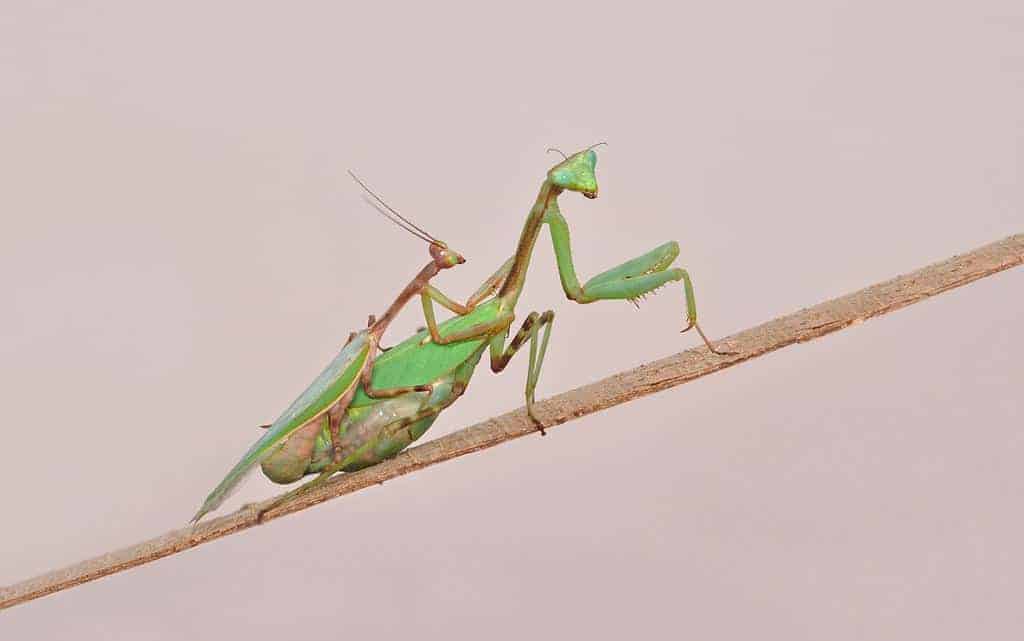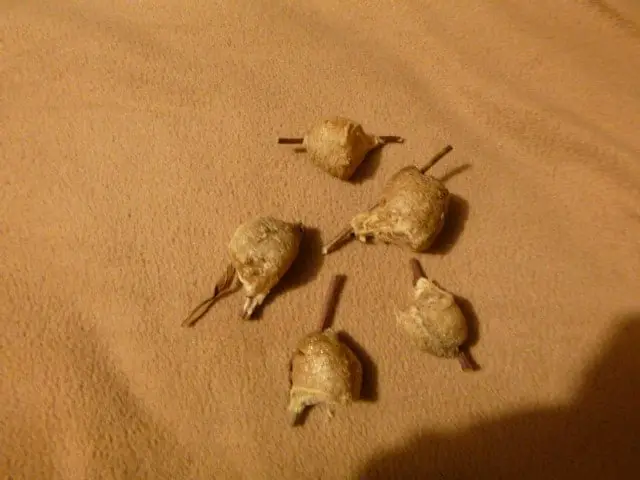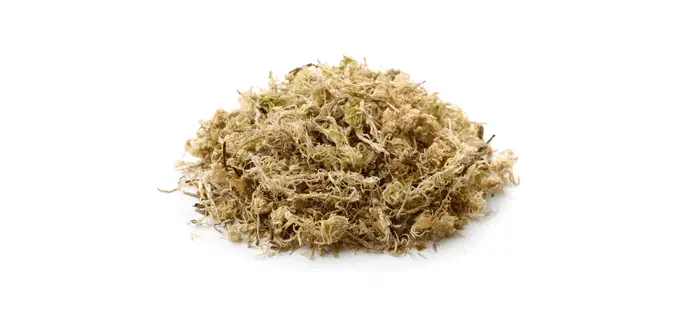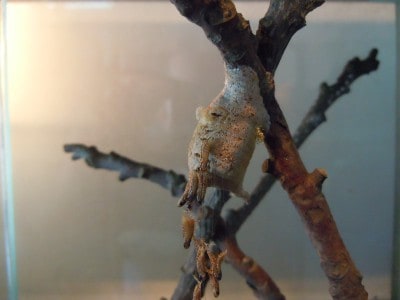It is such a wonderful feeling when you see tiny nymph mantises walk around in your enclosure after you take the effort to breed with your mantis. You can see how your nymphs will develop in adult mantises, and maybe one day breed themselves again.
Breeding of praying mantis can be really rewarding, with some species it can be quite tricky and hard to get them to breed. When you just start with keeping bugs, I don’t recommend you to immediately breed with them because of the chance of losing the male when cannibalized by the female. Although, in general, the few mantis species that you can house in groups and tolerate the presence of each other (from both sexes) are easier to breed in my experience.
The page is to provide practical guidance to prepare you for breeding mantises. It focuses on giving you easy to follow steps and tricks on the breeding process, taking care of the ootheca and mantis nymphs.

The mating process
Almost all mantises need fertilization before laying fertile eggs, in contrast with for example phasmids where many species are parthenogenic. Unfortunately, female mantises have the ruthless habit of eating the male before, during or after mating. You should be aware of this fact when trying to breed mantises, and that it can happen that you lose your male during your effort to breed. Within this section, we discuss the mating process focused on being successful and on increasing the chance of saving the male.
Male-female pair
To be successful with creating a male-female pair, both animals should be adult and reach maturity roughly around the same time. That sounds easier than you think. You need to consider, especially with smaller mantis species, that males reach maturity (much) sooner than females. In addition to that, the male may lose its lust to mate after a few weeks, and particularly males of smaller species have a short lifespan.
In general, females are mature around 4 weeks after their last moult. Males mature around 2 weeks after their final moult. Often smaller mantis species will be mature sooner, and larger mantis species need longer time to be sexually mature.
So you should dive into the development of your species and plan accordingly to match male-female pairs that are mature at approximately at the same time. For many species, a difference in age of a few weeks will do. However, some species, like orchid mantises, have a much greater difference in development. If you do not pay attention, the male can already be dead before the female reaches maturity. This can be difficult when trying to breed.
You can stimulate and accelerate development by feeding them very frequently and keeping them at higher (more optimal) temperatures, but growth and development can only be accelerated to a certain extent.
Preparation and introducing mantises to mate
Below are the steps to make breeding praying mantis for most species a success. These steps are focused on cannibalistic mantis species, not the ones that can be housed in groups and are more tolerant towards each other.
Preparation
- Best would be that both males and females should be mature for 3 weeks, but at least 2 weeks.
- Both males and females should be well fed and in healthy conditions, so offer them as much food as they will accept for 2-3 weeks prior to the introduction. Especially the female should be fed very well, so she will be less willing to eat the male.
- Plan an introduction/breeding location. Different mantis keepers have different preferences. Some keepers like to have a location in an open space, some use a plant to place them on, and some use an old or plain terrarium/aquarium/plastic container. If you use an enclosure, use the largest one you can find. The location should have a proper environment (especially temperature should be good. When placed in containment you can use a heating pad to additionally warm the environment).
- Furnishing is not necessary, but some retreat for the male is advised. This can be a twig to climb up or artificial plant to hide in.
Introduction
- Place the female first onto the location.
- Feed her a large insect item that takes a while to finish (locust, large cricket).
- Place the male behind her so that the female does not see the male, but the male is in a distance of seeing her.
- Both male and female should be calm and not stressed when handling.
- Then the moment comes (often soon) that the couple becomes aware of each other, or at least the male aware of the female. This is the moment of truth. At this moment we hope that male will hop onto the female. Observe the behaviour of both carefully:
- Watch for the female that it is not behaving aggressively, turn around, or move towards the male.
- Watch for the male that it is not moving or flying away, or behave too wildly.
- It may take some time that the male is positioning before it hops onto the female.
- When mounted, the mating process can take one to many hours. Best would be just to leave them and not to disturb them. You can feed the female if you think it keeps her distracted, but it can also trigger the female attack the male. For most species, it is best just to leave them be.
In general, when mating is successful, the female will remain to lay fertile eggs for the rest of her life. However, it can be that the male does not transfer a spermatophore. You can’t, or at least it is really difficult to see if the male fertilizes a female. Therefore it can be wise to try a second time mating the female with another male. Mating a second time even when the female is fertilized doesn’t hurt your female.
Cannibalism towards males
It may happen, and it is quite normal with cannibalistic mantis species, that the female eats the male during the mating process. This can happen before the actual mating occurs, but also during the act or afterwards. When you seriously want to breed, it is recommended that you keep two or more males. If a male is unfortunate during mating before successful copulation happens, you have at least another to give it a try.
Cannibalism towards the male is just a fact you have to deal with when breeding mantises (mostly when keeping cannibalistic mantis species). However, there are some practical tips to reduce the probability that your male is eaten during the mating process, as you can see in this list:
- When you introduce the male to the female, both mantises need to be calm and relaxed from the moment you handle them.
- Make sure the mating is done in a really large container, or even use a complete room. More space makes it easier for the male to escape when things take a turn for the worse.
- Make sure you feed the female a lot before introducing to the male. And I mean really a lot!
- Do the introduction in the evening instead of during the daytime.
Breeding mantises housed in groups
Breeding mantises that can be housed in groups are much easier to breed. It is not more than putting males and females together, and they will figure out the mating by themselves (almost) without losing males. However, your group-housed mantises must be continuously well-fed, especially females. Besides feeding them regularly, we place curly-wing flies in the enclosure so that the mantises can eat whenever they like (but make sure that dead flies are removed from the enclosure regularly).
Species that tolerate each other and can be housed in groups are, amongst others:
- Ghost mantis (Phyllocrania paradoxa)
- Wandering violin mantis (Gongylus gongylodes)
- Zebra mantis (Omomantis zebrata)
- Devil’s flower mantis (Idolomantis diabolica)

Caring for mantis eggs (ootheca)
The female will lay eggs even if the mating was not successful, and unfortunately, you can’t see from the outside of the eggs if they are fertilized. Do not disturb the female when she is laying eggs. Egg and ootheca production costs a lot of energy, and it is worth that when she is finished laying eggs, you provide her food to regain strength. It can be that laying eggs costs so much energy that the female may die afterwards.
When the female has mated, she will lay their eggs within days. Some mantis species lay only a couple of dozen eggs, where other species lay hundreds. But all mantis species have in common that they capsulate the eggs in a foamy substance for insulation and protection. This egg sac is called the ootheca. The freshly laid ootheca is soft, but after a couple of days, it will harden and become pretty tough. It is recommended to separate the female from the ootheca after 3 to 5 days after she laid their eggs. Where the females have produced the ootheca determines how to proceed next.

Prepare the ootheca for hatching
When the female is kept in the container where mating took place, and have laid their eggs in this container, you can remove the female to her original enclosure. You can use this container as an incubation container, at least if the size is large enough for hatching. The container needs to be at least 15cm (6″) high.
Although I can recommend the above method, you can also remove and transfer the ootheca. When the female is placed back to her original enclosure after mating and has produced her ootheca in this enclosure, you’ll need to really carefully remove the ootheca after 5 days when the ootheca is hardened. When the female attached the ootheca on a branch, leaf or any other removable object, you can easily transfer the whole object including the ootheca to a hatching/incubation container and hang it in there. When the ootheca is attached to a flat surface, like a glass window or plastic side of a container, you need to really carefully peel off the ootheca. There is always a risk that you will damage the ootheca om the process.
Make sure the delicate ootheca does not get bumped and do not touch the ootheca unnecessary during transfer. Try to place the ootheca in the exact position that the female has laid the ootheca (most often the ootheca is pointing (slightly) downwards) because gravity plays an important role in hatching mantis eggs. When the ootheca is not attached to an object, you can hang it with a thin thread to a twig or stick to one of the sides/tops of the incubation container. You can attach the thread with a needle through the outer edge of the opposite side of where the eggs will hatch. Or you can use double-sided tape. When using tape, make sure there is no tape sticking out where nymphs will get stuck on.
For species that can be housed in groups, you don’t necessarily need to remove the ootheca from the adults. I have good experience with hatching them inside the adult enclosure. Still, I like to raise them separately from the adults. So after hatching, I move the small nymphs to a separate enclosure to raise them to L4 before introducing them back in the adult enclosure.
As an incubation container, you can use glass (spider) enclosures, acrylic enclosures, plastic containers or plastic deli cups. The incubation container needs adequate ventilation. When no ventilation present, you can cut out a hole and cover it with a very fine screen or drill/poke many small holes in the top or sides of the container. On the bottom, you need to put a substrate to maintain the humidity to prevent the eggs and newly hatched nymphs from drying out. Best to use are paper towels or peat moss for this purpose.

Ootheca care
When you set up your incubation container with the (attached) ootheca, it is time to wait until the eggs hatch. For most species, it will take between 4 to 8 weeks for eggs to hatch. You must provide a proper environment for the mantis ootheca to keep the eggs in good condition.
Besides enough ventilation, maintain proper humidity in the container is essential. The substrate helps with that. Keep the substrate slightly moist by misting some water onto the substrate. Don’t make it too wet! You can let the substrate dry up, but don’t let the substrate be dry for more than 24 hours. Have patience, and soon you’ll be rewarded with many small praying mantis nymphs.

Caring and raising mantis nymphs
For hatching mantis ooth, as discussed earlier, you need enough space downwards. The distance between the ootheca and the substrate should be around 10cm (4″). When the mantis eggs hatch, the larvae (sometimes called worms) release themselves on a thread and moult the first time (free themselves from their worm skin). From that point on, they are a miniature version of their adult looks.
After their first moult, quickly after hatching, the nymphs need to be transferred to an appropriate enclosure where you can care and raise the mantis nymphs. When you want to move the nymphs from one enclosure to another, because they are very fragile, it would be best to use a 1cm (0,5″) flat paint brush.
Because young nymphs (up to L3) are less cannibalistic, you can keep them together in one enclosure. However, you’ll need to provide enough climbing and hiding places and make sure you feed them enough. Feed and check them every 2-3 days. Most young mantis species eat small fruit flies. When the young nymphs have been raised to L4, you’ll need to house them separately to ensure that they don’t cannibalize each other. From that point on, you can also increase the size of food items, like crickets and curly-winged flies.
Share this page!
